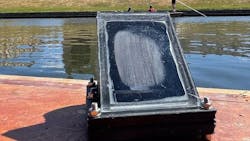Solar-powered device produces clean water, clean fuel
Researchers have developed a floating, solar-powered device that can turn contaminated water or seawater intro both clean hydrogen fuel and purified drinking water, according to a press release from the University of Cambridge.
The device could be useful in resource-limited or off-grid environments, since it works with any open water source and does not require any outside power.
It takes its inspiration from photosynthesis, the process by which plants convert sunlight into food. However, unlike earlier versions of the ‘artificial leaf’, which could produce green hydrogen fuel from clean water sources, this new device operates from polluted or seawater sources and can produce clean drinking water at the same time.
Tests of the device showed it was able to produce clean water from highly polluted water, seawater, and even from the River Cam in central Cambridge. The results are reported in the journal Nature Water.
“Bringing together solar fuels production and water purification in a single device is tricky,” said Dr Chanon Pornrungroj from Cambridge’s Yusuf Hamied Department of Chemistry, the paper’s co-lead author. “Solar-driven water splitting, where water molecules are broken down into hydrogen and oxygen, need to start with totally pure water because any contaminants can poison the catalyst or cause unwanted chemical side-reactions.”
“In remote or developing regions, where clean water is relatively scarce and the infrastructure necessary for water purification is not readily available, water splitting is extremely difficult,” said co-lead author Ariffin Mohamad Annuar. “A device that could work using contaminated water could solve two problems at once: it could split water to make clean fuel, and it could make clean drinking water.”
Pornrungroj and Mohamad Annuar, who are both members of Professor Erwin Reisner’s research group, came up with a design that did just that. They deposited a photocatalyst on a nanostructured carbon mesh that is a good absorber of both light and heat, generating the water vapour used by the photocatalyst to create hydrogen.
The porous carbon mesh, treated to repel water, served both to help the photocatalyst float and to keep it away from the water below, so that contaminants do not interfere with its functionality.
The team used a white, UV-absorbing layer on top of the floating device for hydrogen production via water splitting. The rest of the light in the solar spectrum is transmitted to the bottom of the device, which vaporises the water.
“This way, we’re making better use of the light – we get the vapour for hydrogen production, and the rest is water vapour,” said Pornrungroj. “This way, we’re truly mimicking a real leaf, since we’ve now been able to incorporate the process of transpiration.”
